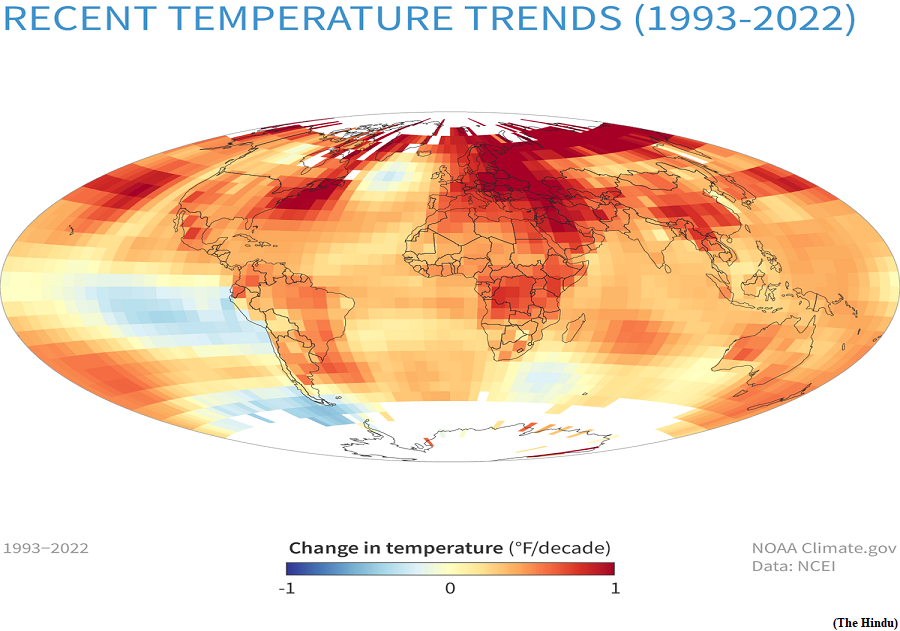Why was the month of March in Mumbai relatively cooler? (GS Paper 1, Geography)

Why in news?
- The month of March in Mumbai was relatively cooler and drier than normal.
- Winds in March usually tend to flow from West Asia to Mumbai, signalling the beginning of a sweltering heat and humidity build-up through May, before the rains arrive in June.
Why was this March cooler and drier?
- A study recently reported that West Asia has been warming more rapidly than other tropical land regions. The northern Arabian Sea has also been warming.
- The combination of this land and ocean warming has enhanced the duration, frequency, and intensity of heat waves over India in the pre-monsoon season.
- Meteorologists have also blamed the northern Arabian-Sea warming for the increase in heavy rainfall events over northwest India in the monsoon season.
- Rapid warming over West Asia produces low sea-level pressure locally, which sets up a northward pressure gradient over the Arabian Sea, from the equator to its northern waters. This gradient pulls winds northward, disrupting those that should actually be flowing east, from West Asia towards Mumbai.
- So the winds came to Mumbai from the north-northwest, bringing cooler and drier air instead of the usual hot and humid air from the desert.
Will this affect monsoons?
Heat waves:
- As seasonal land-heating continues into April and May, the southwesterly winds will set out from the equator into the central Arabian Sea. The normal eastward winds from West Asia towards Mumbai should also get stronger.
- These westerly winds bring heat from West Asia, over the warm Arabian Sea, into India. Winds also sweep in from the northwest over the mountains of Afghanistan and Pakistan, setting up heat waves.
- The evolution of winds and sea surface temperatures clearly show a rapid warming of the North Indian Ocean, especially the Arabian Sea, which augurs even more heat events.
What will be the consequences?
- Reports of unseasonal rain and hail leading to devastating crop damages in the northwest are a preview of what may be in store in terms of heat waves and heavy rain over these parts. Since only about 50% of El Niño years have so far produced a drought over India, it may end up with a ‘normal’ monsoon.
- But it is quite likely that warming over West Asia plus the Arabian Sea is going to once again produce heavy rainfall events over northwest India and Pakistan.
- While Mumbaikars are basking in the unseasonably cool and dry weather, they can also expect heavy rains and flooding this monsoon. Climate models seem confident that there will be an El Niño starting during the monsoon season.
Deep ocean currents near Antarctica on the verge of collapsing: Research
(GS Paper 1, Geography)
Why in news?
- Scientists believe that the deep ocean circulation that forms around Antarctica is on the verge of collapsing.
- Such a decline of this ocean circulation will stagnate the bottom of the oceans and generate further impacts affecting climate and marine ecosystems for centuries to come.

Antarctic overturning:
- Cold water that sinks near Antarctica drives the deepest flow of the overturning circulation, a network of currents that spans the world’s oceans.
- The overturning carries heat, carbon, oxygen and nutrients around the globe. This influences climate, sea level and the productivity of marine ecosystems.
- The modelling shows that if global carbon emissions continue at the current rate, then the Antarctic overturning will slow by more than 40 per cent in the next 30 years and on a trajectory that looks headed towards collapse.
Modelling the deep ocean:
- About 250 trillion tonnes of cold, salty, oxygen-rich water sinks near Antarctica each year. This water then spreads northwards and carries oxygen into the deep Indian, Pacific and Atlantic Oceans.
- The international team of scientists modelled the amount of Antarctic deep water produced under the IPCC ‘high emissions scenario’, until 2050.
- The model captures detail of the ocean processes that previous models haven’t been able to, including how predictions for meltwater from ice might influence the circulation.
- This deep ocean current has remained in a relatively stable state for thousands of years, but with increasing greenhouse gas emissions, Antarctic overturning is predicted to slow down significantly over the next few decades.
Impacts of reduced Antarctic overturning:
- With a collapse of this deep ocean current, the oceans below 4000 metres would stagnate. This would trap nutrients in the deep ocean, reducing the nutrients available to support marine life near the ocean surface.
- The model simulations show a slowing of the overturning, which then leads to rapid warming of the deep ocean.
- The study found melting ice around Antarctica makes the nearby ocean waters less dense, which slows the Antarctic overturning circulation. The melt of the Antarctic and Greenland ice sheets is expected to continue to accelerate as the planet warms.
The Bharat 6G vision document
(GS Paper 3, Science and Tech)
Why in news?
- Recently, the Prime Minister unveiled the Bharat 6G Vision Document, a starting point for policymakers and the industry to gear up for the next generation of telecommunication.
- This is happening even as over 45,000 villages lack 4G connectivity, and 5G networks are still being built out.

Why did the government put out a 6G vision document?
- The government has indicated that it wants to accelerate India’s wireless data consumption and assume leadership in setting the standards for 6G in the coming years. This may involve everything from encouraging local manufacturing of telecom gear to supporting Indian companies and engineers in international discussions around standardisation.
- Another key motivation is the delay in previous generations of telecommunication technology rolling out in India; 5G started rolling out in India years after countries like South Korea and the U.S. had already blanketed their major urban areas with high-speed wireless connectivity. India does not want a repeat of that.
- The frequencies generally increase in newer generations of networks, but the lower the frequency, the longer a cell signal can travel. With increasing data usage, lower frequencies in 4G networks may not physically be able to keep up with the demand for traffic.
Goals:
- guarantee every citizen a minimum bandwidth of 100Mbps;
- ensure every gram panchayat has half a terabit per second of connectivity; and
- blanket the country with over 50 million internet hotspots, with thirteen per square kilometre.
How will 6G be different from 5G?
- For consumers, websites will load faster, videos will look better, and files will download faster, as has been the case with every new generation of technology.
- Latency, which is the time taken for a data packet to move from one place to another (as opposed to speed, which is the number of such packets that can travel on a connection each second), is not far off from the speed of light itself on existing networks.
Satellite Internet:
- According to the vision document, satellite constellations will join telecom towers and base stations, integrating networks and extending them to rural areas.
- Some of the innovations that the government envisions as 6G-powered connectivity boosters are solutions that already exist in other forms.
- For instance, satellite internet in remote areas is a solution that the government can instantly approve by granting firms like Elon Musk’s SpaceX and Bharti Airtel-backed OneWeb the administrative clearance to begin offering their services.
- Like DTH satellite dishes, setup is minimal as the satellites are already in the sky. However, administrative clearances lag behind.
- At least two parts of India have already relied on satellite internet for decades. The Andaman & Nicobar Islands relied on 1Gbps link to connect to the outside world, which is comparable to a single expensive home connection in many Indian cities today. The situation improved vastly after the islands were connected to Chennai by an undersea cable in 2020.




